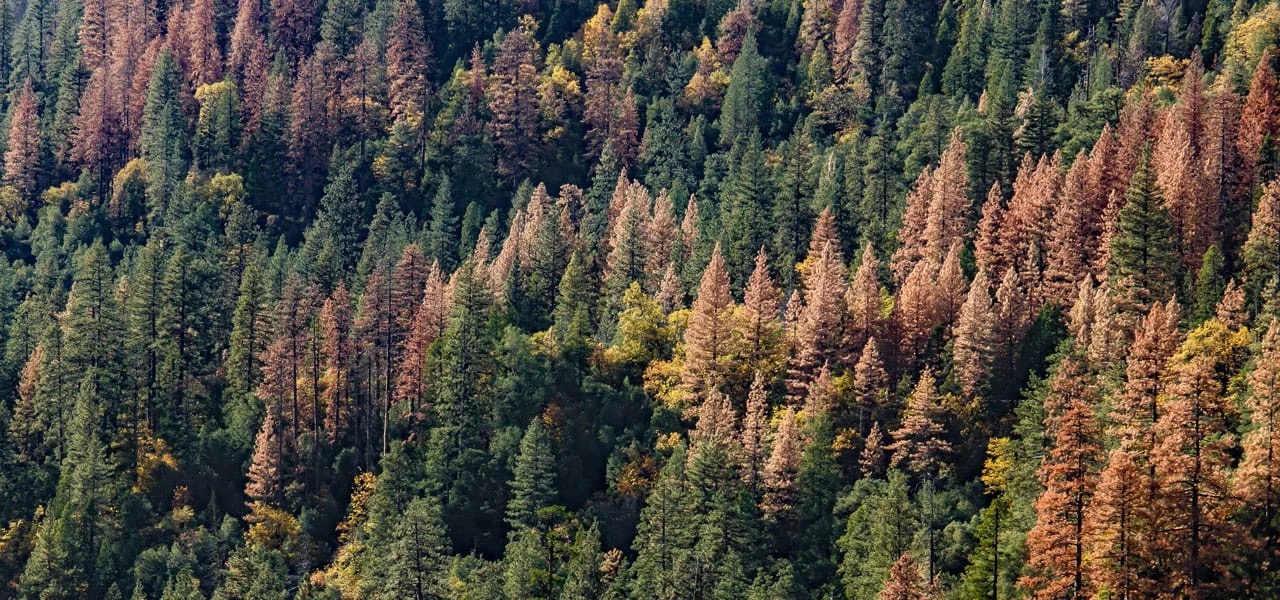At a Glance
Height: 60 to 125 feet
Spread: 20 feet
Shape: Narrow, pyramidal
Exposure: Full sun or partial shade
Native? Yes
Evergreen? Yes
Leaves: Evergreen needles, light blue/green or silver, 1-3 inches long. Needles can smell like citrus.
Fruit or Seed: Cones are purple or olive green to blue, 3-5 inches long, and oblong. They ripen to brown color and become shiny or glossy when ripe.
Firewise? Mature trees are fire-tolerant but young trees do not survive fires
Drought-tolerant? Can withstand drought better than other firs but doesn’t do well with winter salt spray
Bark: Young trees have smooth, light gray bark. Mature trees have ridges and orange cracks in their bark.
Where to Plant: Prefers moist soil with good drainage. Needs 20-60 feet of available space.
Common Problems & Possible Causes
Dense clusters of small branches, slow growth and overall decline – Fir mistletoe (Phoradendron pauciflorum)
Treetop, individual branches, strips of the trunk or even the entire tree turns brown and dies – Fir engraver (Scolytus ventralis) (a bark beetle)

This group of white firs shows typical signs of damage from a fir engraver infestation. Image courtesy of William M. Ciesla, Forest Health Management International, Bugwood.org
About White Fir
White fir (Abies concolor) is a popular evergreen tree found in both forest and urban areas. There are two different varieties found throughout North America. The type found here in Colorado is designated by concolor – so the full name is Abies concolor subsp. concolor. “Concolor” means “all one color,” and this refers to the uniform color of the needles throughout the tree. It is also known as Rocky Mountain white fir.
The other type of white fir tree found in North America is Abies concolor subsp. Iowiana or the Sierra Nevada white fir, found in Oregon, California, and northern Baja California, Mexico. It tends to be taller (130-195 feet tall) and can live longer than the variety found in Colorado.
Whatever the subspecies maybe, white fir is an excellent tree for landscapes that have adequate room for the tree to grow.
It is also a popular Christmas tree, owing to the pyramidal shape, the scent of its needles, and the fact that the needles stay on the tree longer than other types of Christmas trees. If you’re looking for a white fir tree on a Christmas tree lot, it is often labeled as “concolor.”
White firs are popular with the animal population as well. Birds enjoy nesting in the branches, and the lower branches provide a place for owls to hide. Squirrels and birds eat the seeds (found in the cones), porcupines gnaw on the bark, and deer have been known to eat white fir seedlings, buds, and needles (something to keep in mind if you plant a young tree).

Distribution map for Abies concolor (Gord. & Glend.) Lindl. ex Hildebr. (White Fir). Green = Abies concolor subsp. concolor. Blue = Abies concolor subsp. lowiana.
The low branches of this tree, which are so helpful to owls and other birds as they escape predators, are not very firewise. The lower branches can create a fire ladder, bringing fire up not only the white fir but any taller trees around it. To prevent this, it’s a good idea to prune out the lower branches.
A slow-growing tree, white firs can live for over 80 years, though some have been found to be over 300 years old!
While the tree itself is one color, the cones can vary in color (and sometimes change as they grow) from purple to olive green, eventually turning brown and shiny. They grow upright on the tree, unlike other conifer cones, and often disintegrate while still attached to the branches. As the cones come apart, they release winged seeds.
While the wood of white fir trees was once considered sub-par, it is now recognized as a preferred wood for construction. White fir wood holds nails well, is lightweight, and is strong enough for most construction work.
Contact LAM Tree Service if you would like more information about white fir or if you would like to know if one would be appropriate for your property.
Tree Planting
We recommend spring or early fall planting to get your new trees off to a great start. You can always call us for advice on where to plant your new tree(s) and don’t forget that we offer professional tree planting services if you don’t want to do it yourself!
Recommended Trees & Shrubs
Get A Free Quote
Call us at 303-674-8733 or contact us online to get a free estimate for tree planting, general tree services or any aspect of our Plant Health Care program.
























